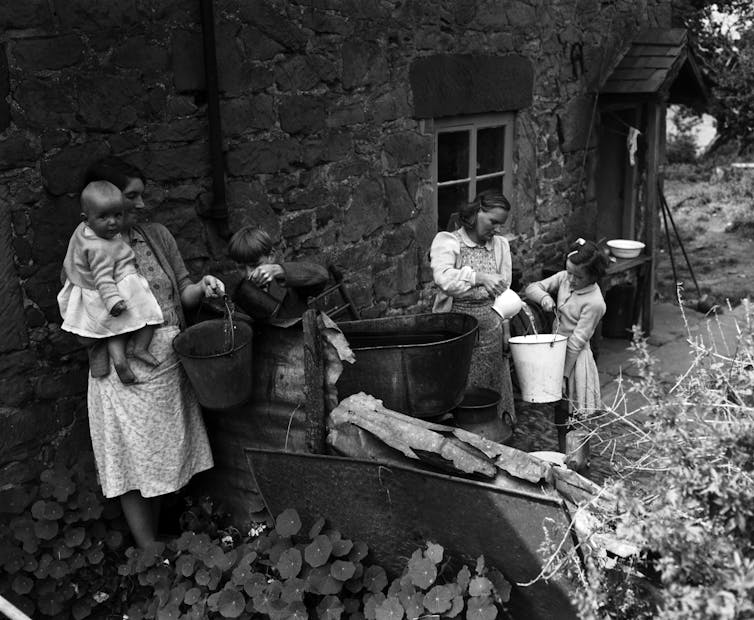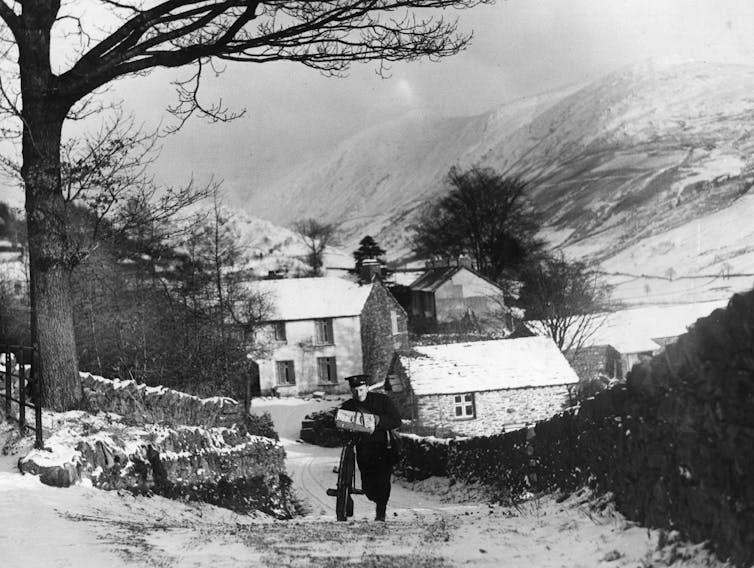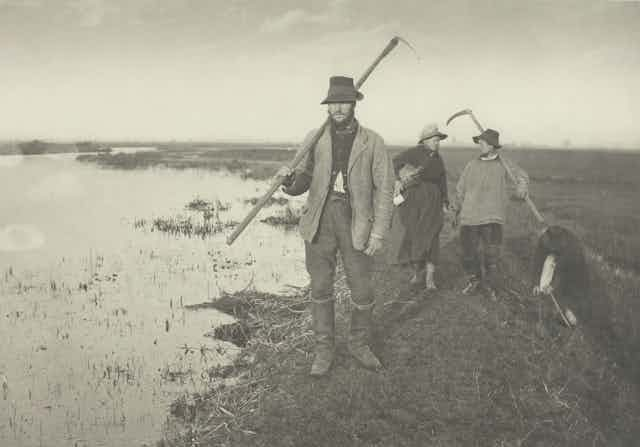If you need to hit a nail, what tool do you ask for? If you say “hammer,” do you pronounce the “r”? Do you drop the “h”?
Different people pronounce the same English words in different ways. People learn which words to use and how to pronounce them as they’re learning to talk with family, friends and others in their community, so geographic patterns in these pronunciations can persist over time.
In England, pairs of words that mean similar things, like “sight” and “vision” or “yes” and “aye,” can reveal a rich history of language that is intertwined with the history of the place itself. Such words have their origins in migrations and conquests that took place during the Middle Ages. New words would sometimes coexist and sometimes displace one another.
Cultural evolution researchers like us know that it’s not just mountain ranges or oceans that can be barriers to interaction. Different people can share their technology, cuisines and ideas, but some tend to interact more often with those who share cultural similarities, a behavior called homophily.
This can be seen most clearly when cultural traditions lead people to marry people from the same community. Populations that tend to marry within their group because of social or economic forces, including religious traditions and social stratification, have smaller gene pools, leading them to be more genetically similar to one another.
In addition to groups with distinctive marital practices, researchers have found relationships between genes and culture when studying groups that are from different ethnicities or different regions of the world. These similarities between genes and culture don’t imply that certain genetic variants are exclusive to these groups, or that genetics causes certain cultures to arise. Rather, the same people might be more likely to share genetics and language because of a common history, especially because of significant geographic or social barriers between groups.
Can smaller things, like the different dialects between neighboring villages, shape the genetic landscape of populations? In our new study, we combined genetic and linguistic data sampled in England to study the effects of culture on genetics at smaller geographic scales than generally studied.
We examined this relationship between cultural and genetic variation across England. In places where people move often, the small correlations between language and genes can be lost because of how rapidly they change. Since Great Britain is an island, few people entered its rural population between the times of the Norman conquest in 1066 and the end of the 19th century, making it ideal for our analysis.

Combining two sets of data
Ideally, we could use a unified data set capturing information about the genetics and dialects of people living in a region. Unfortunately, no such data exists. Instead, we used data from two separate studies of people from approximately the same time and place. For our research, we focused on where the data sets overlapped in England.
For linguistic data, we relied on the Survey of English Dialects. Between 1950 and 1961, interviewers visited over 300 mostly rural places and asked people hundreds of questions about their daily lives. Their answers recorded the phrases, terms and sounds of local dialects of English. Each of these words can carry clues about where, or with whom, a person grew up.
The genetic data we used came from the People of the British Isles project, an academic investigation of how much Britain’s historical events of conquest, war and migration are reflected in British genetics. The project sequenced DNA from more than 2,000 people in Great Britain and Northern Ireland. Researchers genotyped people whose grandparents who were born within 50 miles (80 kilometers) of each other, were largely rural, and were born in the late 19th century.
The People of the British Isles project found that most genotypes were not local to any one part of Great Britain but were evenly distributed. However, the historical movements of people to Great Britain left genetic marks: Compared with people in the rest of Great Britain, the genetics of those from the south of England were slightly more similar to those in France – a result of the Norman conquest a millennium ago – and the genetics of people in the former Danelaw were slightly more similar to modern Danes – because of the settling of the region by Vikings and, later, Danes. These events resulted in groups of people with somewhat similar genetics, a phenomenon referred to as genetic clustering.
We used features from the Survey of English Dialects to measure where neighboring towns spoke the most differently, which occurs at the borders between dialects. When people from neighboring towns speak the same dialect, we expect features of their language, such as whether the “r” is pronounced at the ends of words, to be similar. Conversely, if nearby towns speak different dialects, their language features will be more different.
Many of these dialect boundaries have long histories, such as that separating the English of the North from that of the South of England. Over time, dialects can persist in similar locations if geographic or cultural barriers influence how often and with whom people interact.

The echo of sounds long gone
We found greater genetic differences at the borders between dialects. Our results suggest that language, or some other aspect of culture, has limited how people interacted to some degree over the past thousand years. By limiting how often people started families with those from neighboring groups, cultural differences have maintained genetic evidence of the Norman conquest and other events from the Middle Ages.
This is the first time that information about linguistic dialects has been compared with modern genetic data within a population, particularly at such a granular level. Notably, people speaking different dialects have no obvious reason to avoid marrying one another, as would be expected from groups with specific marriage customs. Nevertheless, we find that even small-scale language differences, or other aspects of culture associated with these differences, can leave an impression on genes via people’s mating behaviors.
Even though people outside of Britain may think of a general “British accent,” the subtle differences among dialects seem to have parallels with the genetics of the region. This is in spite of the fact that the languages brought by people coming to England have since mixed and merged to produce the modern English language and today’s dialects.
The data used in our study represents the genetic landscape and dialects of the late 19th century; both have changed significantly since then. After the introduction of radio and television, dialects became more influenced by the cities around them. As a result, features of many English dialects in England, such as the pronunciation of “r” at the ends of syllables, have become much less common.
At the same time, immigrants from the former British Empire and elsewhere have brought a new influx of language. The cities in Great Britain have developed a set of new dialects rooted in the interactions among people from all ethnicities. As cultural barriers among groups fall away, small human interactions form the bridges that allow people to deemphasize differences and learn from one another.
This article has been updated to clarify which parts of the United Kingdom were included in the different data sets and the authors’ study.

